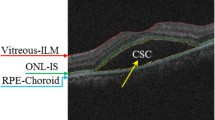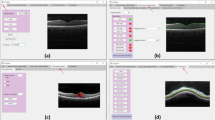Abstract
The posterior segment of the human eye complex contains two discrete microstructure and vasculature network systems, namely, the retina and choroid. We present a single segmentation framework technique for segmenting the entire layers present in the chorio-retinal complex of the human eye using optical coherence tomography (OCT) images. This automatic program is based on the graph theory method. This single program is capable of segmenting seven layers of the retina and choroid scleral interface. The graph theory was utilized to find the probability matrix and subsequent boundaries of different layers. The program was also implemented to segment angiographic maps of different chorio-retinal layers using “segmentation matrices.” The method was tested and successfully validated on OCT images from six normal human eyes as well as eyes with non-exudative age-related macular degeneration (AMD). The thickness of microstructure and microvasculature for different layers located in the chorio-retinal segment of the eye was also generated and compared. A decent efficiency in terms of processing time, sensitivity, and accuracy was observed compared to the manual segmentation and other existing methods. The proposed method automatically segments whole OCT images of chorio-retinal complex with augmented probability maps generation in OCT volume dataset. We have also evaluated the segmentation results using quantitative metrics such as Dice coefficient and Hausdorff distance This method realizes a mean descent Dice similarity coefficient (DSC) value of 0.82 (range, 0.816–0.864) for RPE and CSI layer.
Graphical abstract














Similar content being viewed by others
References
Ahn SM, Lee SY, Hwang SY, Kim SW, Oh J, Yun C (2018) Retinal vascular flow and choroidal thickness in eyes with early age-related macular degeneration with reticular pseudodrusen. BMC Ophthalmol 18(1):1–10. https://doi.org/10.1186/s12886-018-0866-3
Bandara AMRR, Giragama (2017) A retinal image enhancement technique for blood vessel segmentation algorithm. In: 2017 IEEE international conference on industrial and information systems (ICIIS) (pp 1–5). IEEE. https://doi.org/10.1109/ICIINFS.2017.8300426
Bhayana AA, Kumar V, Tayade A, Chandra M, Chandra P, Kumar A (2019) Choroidal thickness in normal Indian eyes using swept-source optical coherence tomography. Indian J Ophthalmol 67(2):252. https://doi.org/10.4103/ijo.IJO_668_18
Booij JC, Baas DC, Beisekeeva J, Gorgels TG, Bergen AA (2010) The dynamic nature of Bruch’s membrane. Prog Retin Eye Res 29(1):1–18. https://doi.org/10.1016/j.preteyeres.2009.08.003
Chan A, Duker JS, Ko TH, Fujimoto JG, Schuman JS (2006) Normal macular thickness measurements in healthy eyes using Stratus optical coherence tomography. Arch Ophthalmol 124(2):193–198. https://doi.org/10.1001/archopht.124.2.193
Chen Q, Fan W, Niu S, Shi J, Shen H, Yuan S (2015) Automated choroid segmentation based on gradual intensity distance in HD-OCT images. Opt Express 23(7):8974–8994. https://doi.org/10.1364/OE.23.008974
Chen X, Niemeijer M, Zhang L, Lee K, Abràmoff MD, Sonka M (2012) Three-dimensional segmentation of fluid-associated abnormalities in retinal OCT: probability constrained graph-search-graph-cut. IEEE Trans Med Imaging 31(8):1521–1531. https://doi.org/10.1109/TMI.2012.2191302
Chiu SJ, Allingham MJ, Mettu PS, Cousins SW, Izatt JA, Farsiu S (2015) Kernel regression based segmentation of optical coherence tomography images with diabetic macular edema. Biomed Opt Express 6(4):1172–1194. https://doi.org/10.1364/BOE.6.001172
Chiu SJ, Li XT, Nicholas P, Toth CA, Izatt JA, Farsiu S (2010) Automatic segmentation of seven retinal layers in SDOCT images congruent with expert manual segmentation. Opt Express 18(18):19413–19428. https://doi.org/10.1364/OE.18.019413
Costa J, Farré M (2010) Corticotrophins, corticosteroids, and prostaglandins. In: Side Effects of Drugs Annual (vol 32, pp 723–733). Elsevier. https://doi.org/10.1016/S0378-6080(10)32039-3
Coye T (2015) A novel retinal blood vessel segmentation algorithm for fundus images. MATLAB Central File Exchange
De Giorgi V, Stante M, Massi D, Mavilia L, Cappugi P, Carli P (2005) Possible histopathologic correlates of dermoscopic features in pigmented melanocytic lesions identified by means of optical coherence tomography. Exp Dermatol 14(1):56–59. https://doi.org/10.1111/j.0906-6705.2005.00229.x
Dufour PA et al (2013) Graph-based multi-surface segmentation of OCT data using trained hard and soft constraints. IEEE Trans Med Imaging 32(3):531–543. https://doi.org/10.1109/TMI.2012.2225152
Duran AAE, Juarez PC, Nino-de-Rivera L (2018) Optical coherence tomography image analysis to segment the choroid by a new method: selection of ranges by color tonality. Clin Res Ophthalmol 1(1):1–5
Esmaeelpour M, Kajic V, Zabihian B, Othara R, Ansari-Shahrezaei S, Kellner L, Krebs I, Nemetz S, Kraus MF, Hornegger J, Fujimoto JG, Drexler W, Binder S (2014) Choroidal Haller’s and Sattler’s layer thickness measurement using 3-dimensional 1060-nm optical coherence tomography. PLoS ONE 9(6):e99690. https://doi.org/10.1371/journal.pone.0099690
Fang L, Cunefare D, Wang C, Guymer RH, Li S, Farsiu S (2017) Automatic segmentation of nine retinal layer boundaries in OCT images of non-exudative AMD patients using deep learning and graph search. Biomed Opt Express 8(5):2732–2744. https://doi.org/10.1364/BOE.8.002732
Farsiu S, Chiu SJ, Izatt JA, Toth CA (2008) Fast detection and segmentation of drusen in retinal optical coherence tomography images. In: Ophthalmic Technologies XVIII (vol 6844, pp 48–59). SPIE. https://doi.org/10.1117/12.768624
Gambichler T, Regeniter P, Bechara FG, Orlikov A, Vasa R, Moussa G, Stücker M, Altmeyer P, Hoffmann K (2007) Characterization of benign and malignant melanocytic skin lesions using optical coherence tomography in vivo. J Am Acad Dermatol 57(4):629–637. https://doi.org/10.1016/j.jaad.2007.05.029
Girish GN, Kothari AR, Rajan J (2020) Marker controlled watershed transform for intra-retinal cysts segmentation from optical coherence tomography B-scans. Pattern Recogn Lett 139:86–94. https://doi.org/10.1016/j.patrec.2017.12.019
Hu Z, Wu X, Ouyang Y, Ouyang Y, Sadda SR (2013) Semiautomated segmentation of the choroid in spectral-domain optical coherence tomography volume scans. Invest Ophthalmol Vis Sci 54(3):1722–1729. https://doi.org/10.1167/iovs.12-10578
Kaur M, Gill JS (2017) Study on retinal vessel segmentation techniques based on fundus images. Adv Comput Sci Technol 10(5):1317–1325
Kocay W, Kreher DL (2016) Graphs, algorithms, and optimization. Chapman and Hall/CRC
Kugelman J, Alonso-Caneiro D, Read SA, Hamwood J, Vincent SJ, Chen FK, Collins MJ (2019) Automatic choroidal segmentation in OCT images using supervised deep learning methods. Sci Rep 9(1):1–13. https://doi.org/10.1038/s41598-019-49816-4
Kumar NS, Radhika Y (2019) Optimized maximum principal curvatures based segmentation of blood vessels from retinal images. Biomed Res 30(2). https://doi.org/10.35841/biomedicalresearch.30-19-068
Lang A, Carass A, Hauser M, Sotirchos ES, Calabresi PA, Ying HS, Prince JL (2013) retinal layer segmentation of macular OCT images using boundary classification. Biomed Opt Express 4(7):1133–1152. https://doi.org/10.1364/BOE.4.001133
Lau JK, Cheung SW, Collins MJ, cho P (2019) Repeatability of choroidal thickness measurements with Spectralis OCT images. BMJ Open Ophthalmol 4(1):e000237. https://doi.org/10.1136/bmjophth-2018-000237
Lezama J, Mukherjee D, McNabb RP, Sapiro G, Kuo AN, Farsiu S (2016) Segmentation guided registration of wide field-of-view retinal optical coherence tomography volumes. Biomed Opt Express 7(12):4827. https://doi.org/10.1364/BOE.7.004827
Li K, Wu X, Chen DZ, Sonka M (2005) Optimal surface segmentation in volumetric images-a graph-theoretic approach. IEEE Trans Pattern Anal Mach Intell 28(1):119–134. https://doi.org/10.1109/TPAMI.2006.19
Masood S, Fang R, Li P, Li H, Sheng B, Mathavan A, Wang X, Yang P, Wu Q, Qin J, Jia W (2019) Automatic choroid layer segmentation from optical coherence tomography images using deep learning. Sci Rep 9(1):1–18. https://doi.org/10.1038/s41598-019-39795-x
Mazzaferri J, Beaton L, Hounye G, Sayah DN, Costantino S (2017) Open-source algorithm for automatic choroid segmentation of OCT volume reconstructions. Sci Rep 7:42112. https://doi.org/10.1038/srep42112
Mishra Z, Ganegoda A, Selicha J et al (2020) Automated retinal layer segmentation using graph-based algorithm incorporating deep-learning-derived information. Sci Rep 10:9541. https://doi.org/10.1038/s41598-020-66355-5
Niu S, de Sisternes L, Chen Q, Leng T, Rubin DL (2016) Automated geographic atrophy segmentation for SD-OCT images using region-based CV model via local similarity factor. Biomed Opt Express 7(2):581–600. https://doi.org/10.1364/BOE.7.000581
Oliveira J, Pereira S, Gonçalves L, Ferreira M, Silva CA (2017) Multi-surface segmentation of OCT images with AMD using sparse high order potentials. Biomed Opt Express 8(1):281–297. https://doi.org/10.1364/BOE.8.000281
Patel NK, Thirumeni T, John R, Prabhu PV (2015) Automated three-dimensional segmentation of retinal OCT images. Int J Res Eng Technol 4(12):60–65
Poddar R, Basu M (2020) Characterization and oxygen saturation study of human retinal blood vessels evaluated by spectroscopic Optical Coherence Tomography Angiography. Opt Laser Technol 122:105886. https://doi.org/10.1016/j.optlastec.2019.105886
Poddar R, Migacz JV, Schwartz DM, Werner JS, Gorczynska I (2017) Challenges and advantages in wide-field optical coherence tomography angiography imaging of the human retinal and choroidal vasculature at 1.7-MHz A-scan rate. J Biomed Opt 22(10):106018. https://doi.org/10.1117/1.jbo.22.10.106018
Rossant F et al (2015) Parallel double snakes. Application to the segmentation of retinal layers in 2d-oct for pathological subjects. Pattern Recognit 48(12):3857–3870
Rossant F, Ghorbel I, Bloch I, Paques M, Tick S (2009) Automated segmentation of retinal layers in OCT imaging and derived ophthalmic measures. In: 2009 IEEE International Symposium on Biomedical Imaging: From Nano to Macro (pp 1370–1373). IEEE. https://doi.org/10.1109/ISBI.2009.5193320
Salafian B, Kafieh R, Rashno A, Pourazizi M, Sadri S (2018) Automatic segmentation of choroid layer in edi oct images using graph theory in neutrosophic space. arXiv preprint arXiv:1812.01989. https://doi.org/10.48550/arXiv.1812.01989
Srinivasan PP, Kim LA, Mettu PS, Cousins SW, Comer GM, Izatt JA, Farsiu S (2014) Fully automated detection of diabetic macular edema and dry age-related macular degeneration from optical coherence tomography images. Biomed Opt Express 5(10):3568–3577. https://doi.org/10.1364/BOE.5.003568
Tchinda BS, Tchiotsop D, Noubom M, Louis-Dorr V, Wolf D (2021) Retinal blood vessels segmentation using classical edge detection filters and the neural network. Inform Med Unlocked 23:100521. https://doi.org/10.1016/j.imu.2021.10052
Tian J, Varga B, Somfai GM, Lee WH, Smiddy WE, DeBuc DC (2015) Real-time automatic segmentation of optical coherence tomography volume data of the macular region. PLoS ONE 10(8):e0133908. https://doi.org/10.1371/journal.pone.0133908
Wang J, Wang Z, Li F, Qu G, Qiao Y, Lv H, Zhang X (2019) Joint retina segmentation and classification for early glaucoma diagnosis. Biomed Opt Express 10(5):2639–2656. https://doi.org/10.1364/BOE.10.002639
Wang Z, Huang D, Meng H, Tang C (2013) A new fast algorithm for solving the minimum spanning tree problem based on DNA molecules computation. Biosystems 114(1):1–7. https://doi.org/10.1016/j.biosystems.2013.07.007
Wieclawek W, Pietka E (2015) Watershed based intelligent scissors. Comput Med Imaging Graph 43:122–129. https://doi.org/10.1016/j.compmedimag.2015.01.003
Wolff B, Matet A, Vasseur V, Sahel JA, Mauget-Faÿsse M (2012) En face OCT imaging for the diagnosis of outer retinal tubulations in age-related macular degeneration. Journal of ophthalmology. https://doi.org/10.1155/2012/542417
Xiang D, Tian H, Yang X, Shi F, Zhu W, Chen H, Chen X (2018) Automatic segmentation of retinal layer in OCT images with choroidal neovascularization. IEEE Trans Image Process 27(12):5880–5891. https://doi.org/10.1109/tip.2018.2860255
Yan Z, Yang X, Cheng KT (2018) Joint segment-level and pixel-wise losses for deep learning based retinal vessel segmentation. IEEE Trans Biomed Eng 65(9):1912–1923. https://doi.org/10.1109/TBME.2018.2828137
Yavuz Z, Köse C (2017) Blood vessel extraction in color retinal fundus images with enhancement filtering and unsupervised classification. J Healthc Eng 2017. https://doi.org/10.1155/2017/4897258
Yiu G, Pecen P, Sarin N, Chiu SJ, Farsiu S, Mruthyunjaya P, Toth CA (2014) Characterization of the choroid-scleral junction and suprachoroidal layer in healthy individuals on enhanced-depth imaging optical coherence tomography. JAMA Ophthalmol 132(2):174–181. https://doi.org/10.1001/jamaophthalmol.2013.7288
Zhou H, Chu Z, Zhang Q, Dai Y, Gregori G, Rosenfeld PJ, Wang RK (2018) Attenuation correction assisted automatic segmentation for assessing choroidal thickness and vasculature with swept-source OCT. Biomed Opt Express 9(12):6067–6080. https://doi.org/10.1364/BOE.9.006067
Funding
This research is supported by the Indian Council of Medical Research (ICMR)–EMR 5/3/8/30/2020-ITR and DST SERB (No. CRG/2022/001404-G), Government of India.
Author information
Authors and Affiliations
Contributions
VS: methodology, algorithms, and writing—original draft. MM and ZA: data curation and writing—review. RP: conceptualization, algorithms development, writing—review and editing, and supervision.
Corresponding author
Ethics declarations
Competing interests
The authors declare no competing interests.
Additional information
Publisher's Note
Springer Nature remains neutral with regard to jurisdictional claims in published maps and institutional affiliations.
Rights and permissions
Springer Nature or its licensor (e.g. a society or other partner) holds exclusive rights to this article under a publishing agreement with the author(s) or other rightsholder(s); author self-archiving of the accepted manuscript version of this article is solely governed by the terms of such publishing agreement and applicable law.
About this article
Cite this article
Poddar, R., Shukla, V., Alam, Z. et al. Automatic segmentation of layers in chorio-retinal complex using Graph-based method for ultra-speed 1.7 MHz wide field swept source FDML optical coherence tomography. Med Biol Eng Comput 62, 1375–1393 (2024). https://doi.org/10.1007/s11517-023-03007-6
Received:
Accepted:
Published:
Issue Date:
DOI: https://doi.org/10.1007/s11517-023-03007-6




